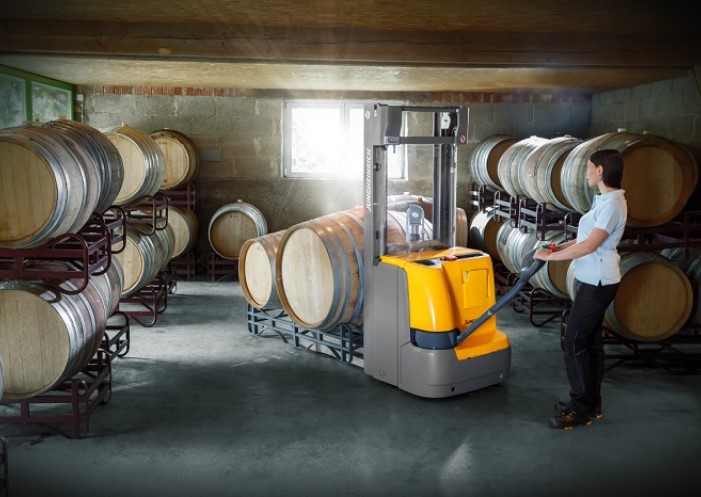Table of contents
Forklift stability refers to the tipping safety of front load transport, with or without a load. The stability of a truck depends on various factors. These include the construction of the vehicle, the environment in which the industrial truck is used, and the requirements it must meet. Only when all these factors are taken into account can the forklift truck be used safely.
Design and situational features relating to forklift stability
Design features determine the stability of forklifts and stacker trucks. These include:
- The respective centre of gravity position of the forklift truck
- The centre of gravity of the load
- The sum of these centres of gravity
However, situational factors within the human-truck-load system also influence stability. These include:
- Load centre of gravity distance
- Reduced load capacity at high lift heights
- Increased danger of tipping over when cornering
Basic principles for the stability of forklift trucks
To ensure forklift trucks can be moved safely with or without loads, and that the vehicle, driver, ortransported goods are damaged, the stability or tipping safety must be calculated. The corresponding formula can be applied to all types of forklift trucks.
Depending on the type of equipment, there are various official safety standards that prescribe how high or up to what load the stability must be guaranteed. To calculate forklift stand stability, you should know the following terms:
Proof of stability
Stability certification proves that a truck is stable enough to meet the relevant requirements. There are fixed regulations in cases where proof must be provided. The calculation may also only be carried out by specialists with the relevant professional experience, such as engineers or construction technicians.
Stall torque
The stall torque is the force that ensures that the truck stands and travels without tipping over. It is made up of the weight and the counterweight of the truck. If the stall torque is greater than the tipping force, stability is ensured. However, depending on where the centre of gravity of the truck is located, the counterweight can also contribute to tipping. The centre of gravity shifts, for example, if the load is too heavy or if the truck drives over a sloping surface.
Tilting torque
The tilting torque is the force that can cause the truck to overturn if it is stronger than the stall torque. Tilting is caused, for example, by loads projecting beyond the tipping axis, wind and other external forces.
Torque
Whether the truck actually tilts can be determined from the torque. The greater this is, and the greater the leverage applied to the truck, the more likely it is that the truck will tip.
Stability factor
The stability factor describes the relationship between overturning torque and stall torque. The higher it is, the more stable the truck will be. Different stability factors are prescribed for different machines. They depend on how often and for how heavy loads the machine is used.
Calculate stability
It is possible to calculate forklift stability using a simple formula:

SS stands for stability, MS for stall torque and MK for tipping torque. The result of the calculation can be interpreted as follows:
- The truck tilts when SS < 1
- The tipping limit is reached when SS = 1
- The truck is stable if SS > 1
The risk of tipping increases the closer the overall centre of gravity of the tipping axis is. This is located along the front wheel axle of the truck. The further the value for Ss is above 1, the more stable the truck will be.
Stability of three-wheel forklifts
Without a load, the centre of gravity of a three-wheel truck is relatively far back on the centre axle of the vehicle, due to the counterweight. Between the wheels is the so-called standing triangle. The forklift can tilt over these axles. The smaller the distance of the centre of gravity (aS) from one of the tipping edges, the lower the stability. For the three-wheel truck, this means that it can fall over the lateral tipping edges relatively easily without a load.

When the driver picks up a load, the load centre of gravity is ideally at half the load length. The sum of both load centres of gravity shifts to the tipping axis over the load axis (AB) with higher load weight.
If the load (or the load force from the load and load arm) becomes too large, the centre of gravity shifts over the front tipping axle and the truck falls forwards onto the forks. However, the height of the centre of gravity above the ground is also important in the centre of gravity position. The higher the centre of gravity, the more unstable the system.
Stability of four-wheel forklift trucks
On four-wheel forklift trucks, point C is at the height of the steering axle mount. Viewed from the side, the stand triangle thus stretches upwards at an angle. As a result, the truck’s centre of gravity is higher. In principle, the steering axle of the four-wheel truck is designed as a swing axle. The suspension is in the middle of the steering axle (on the three-wheel truck, the rear wheel is mounted here).
Four-wheel trucks also form a standing triangle because of the swing axle. When the load is lifted, the centre of gravity continuously shifts upwards, and so does the overall centre of gravity of the truck. In addition, it is influenced by the mast tilt. When leaning forward with the load lifted, the centre of gravity shifts significantly forward. To ensure stability, the mast may only be tilted forward over standing loads.
Image source:
© gettyimages.de – vm























